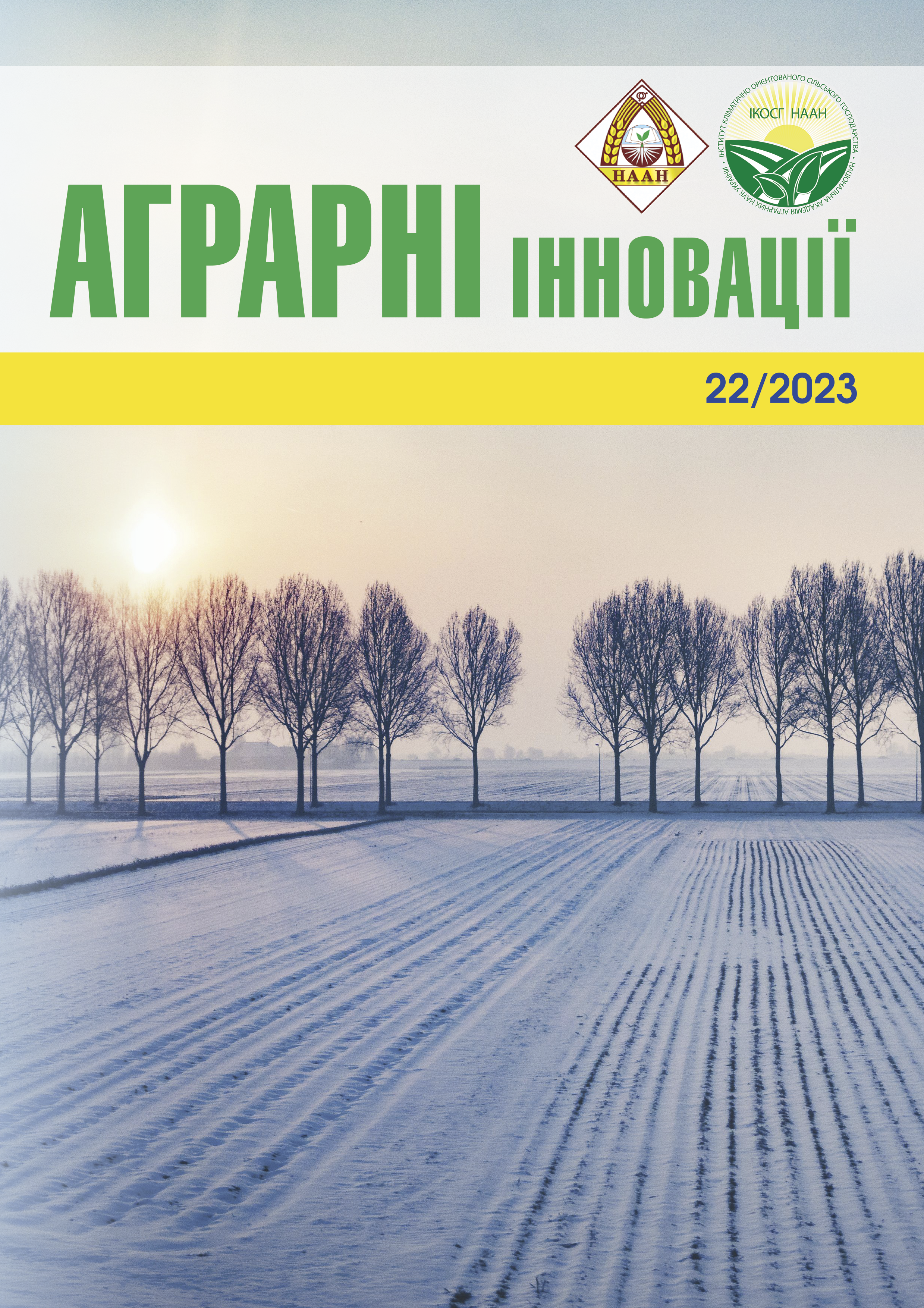ANALYSIS OF AGROMETEOROLOGICAL CONDITIONS DURING THE VEGETATIVE PERIOD OF WINTER WHEAT IN VINNYTSIA REGION
Abstract
Objective. The aim of this study is to analyze the agrometeorological conditions during the vegetative periods of winter wheat in the Vinnytsia region for the years 2016-2019. Methods. Theoretical aspects of the research are based on classical scientific methods such as information analysis, synthesis, analogy, and scientific generalization of literary sources. The practical part involves the application of classical methods of agrometeorological calculations and summarizations. Results. The analysis of weather conditions during the vegetative periods of winter wheat (September to August) for the years 2016-2017, 2017-2018, and 2018-2019 was conducted. The winter period considered was from November to March, as the cessation of winter wheat vegetation occurs on average on November 9th, and its renewal on March 28th. Temperature and precipitation are considered critical factors influencing the growth, development, and yield of crops. Analyzing the specified years, it was determined that the average temperature during the vegetative period in 2016-2017 exceeded the long-term average by 0.9 °C, with precipitation at 88% of the norm. In 2017-2018, the average temperature exceeded the long-term average by 1.7 °C, with precipitation at 106% of the norm. In 2018-2019, the average temperature was 1.3 °C higher, with precipitation at 90% of the norm. According to the hydrothermal coefficient (HTC), the vegetative year 2016-2017 was sufficiently moist (HTC = 1.5), 2017-2018 was also sufficiently moist (HTC = 1.4), and 2018-2019 was normal (HTC = 1.2). No dangerous meteorological phenomena were observed during the wintering period in the studied years. The soil temperature at the depth of the winter wheat node did not fall below -6.6 °C, posing no significant threat to winter crops, as even for poorly developed plants, the critical freezing temperature is -11.5 °C. It was established that the duration of the cold period was the longest in 2016-2017, while the sum of temperatures below 0 ºС was the lowest (-324) ºС. The average height of the snow cover was 8 cm on average, with an average depth of soil freezing of 30 cm. In 2017–2018, the absolute minimum air temperature was the highest – (-21.8) ºС. At the same time, the average height of the snow cover was 8 cm, and the depth of soil freezing did not exceed 28 cm. In 2018-2019, the overwintering period was noted as the warmest among those studied. Thus the absolute minimum temperature did not exceed (-15.7) ºС at the temperature of the coldest month (-4.8) ºС. Snow fell in the period from November to January, the maximum height of the snow cover was 19 cm. Conclusion. The agrometeorological conditions during the studied years significantly differed in temperature regime and moisture content during both the vegetative period and specific stages of winter wheat development. Overall, the dynamics of agrometeorological indicators corresponded to the average conditions in the Vinnytsia region, meeting the biological requirements of winter wheat. The most favorable year in all aspects was 2018-2019, with agrometeorological conditions leading to the highest yield over the studied years – 6.79 t/ha.
References
2. Anderson W. B., Seager R., Baethgen W. et al. Synchronous crop failures and climate-forced production variability. Science Advances. 2019. Vol. 5 Issue 7. DOI: 10.1126/sciadv.aawl 976.
3. Carter T. R., Parry M. L., Porter J. H. Climatic-Change and future agroclimatic potential in Europe. International Journal Of Climatology. 1991. Vol. 11. Issue 3.
P. 251-269.
4. Дмитренко В. П. Зміни клімату і проблеми сталого розвитку України. Проблеми сталого розвитку України. К. : БМТ, 2001. С. 371–384
5. Дмитренко В. П. Погода, клімат і урожай польових культур: монографія. Київ: Ніка-Центр, 2010. 620 с.
6. Степаненко С. М., Польовий А. М. Кліматичні ризики функціонування галузей економіки України в умовах зміни клімату: монографія. Одеса: «ТЭС», 2018. 548 с.
7. Польовий А. М., Кульбіда М. І., Адаменко Т. І., Трофімова І. В. Моделювання впливу зміни клімату на агрокліматичні умови вирощування та фотосинтетичну продуктивність озимої пшениці в Україні. Український гідрометеорологічний журнал. 2007. № 2. С. 76–91.
8. Балабух В. О., Однолєток Л. П., Кривошеїн О. Вплив зміни клімату на продуктивність озимої пшениці в Україні у періоди вегетаційного циклу.
Гідрологія, гідрохімія і гідроекологія. 2017. № 3 (46). С. 72–85.
9. Круковська А.В. Агрокліматична оцінка умов вологозабезпечення основних зернових культур в Україні. Український гідрометеорологічний журнал. 2008. № 3. С. 109–116.
10. Кирнасівська Н. В., Колеснікова О. А. Агрокліматична оцінка вологозабезпеченості періоду вегетації озимої пшениці у Вінницькій області. Вісник Полтавської державної академії. 2021. № 4(103). С. 71–79 doi: 10.31210/visnyk2021.04.08
11. Jahangirov A. A., Jahangirov A. A., Hamidov H. N., Huseynova I. M. The Study of the Sum of Active Temperatures Affecting Autumn Bread (Triticumaestivum L.) Wheat Under Dry Rainfed Conditions. Ekin Journal of Crop Breeding and Genetics. 2017. Vol. 3. No 2. Рр. 53–59.
12. Дубовий В. І., Парфенюк С. М. Особливості зимостійкості та способи екологічної оцінки морозостійкості озимих зернових культур. Агроекологічний журнал. 2016. № 3. С. 95–100.
13. Хоменко Л. О. Оцінка кліматичних умов 2012–2014 років та їхній вплив на формування морозо- й зимостійкості пшениці м’якої озимої. Сортовивчення та охорона прав на сорти рослин. 2014. № 3. С. 49–53.
14. Armonienė Rita, Liatukas Žilvinas, Brazauskas Gintaras. Evaluation offreezing toleranceo fwinter wheat (Triticumaestivum L.) undercontroll edconditions
and in thefield. Zemdirbyste-Agriculture. 2013. Vol. 100, No. 4. p. 417‒424. DOI 10.13080/z-a.2013.100.053
15. Кривобок О. А., Кривошеїн О. О., Адаменко Т. І., Рубан Т. М. Оцінка стану озимої пшениці після перезимівлі з використанням системи CGMS. Геополітика і екогеодинаміка регіонів. 2014. С 663–667
16. Адаменко Т. І. Особливості адаптації системи CGMS для оперативної оцінки стану та прогнозу врожайності озимої пшениці в Україні. Праці УкрНДГМІ. 2001. № 261. С. 118–129.
17. Ляшенко Г. В. Практикум з агрокліматології: навчальний посібник. Одеса: «ТЕС», 2014. 161 с.
18. Агрокліматичний довідник по Вінницькій області: (1986 – 2005 рр.) / за редакцією начальника Вінницького ЦГМ М. М. Кощавки та к. геогр. н. Т. І. Адаменко. Вінниця: Астропринт, 2010. С. 209.






